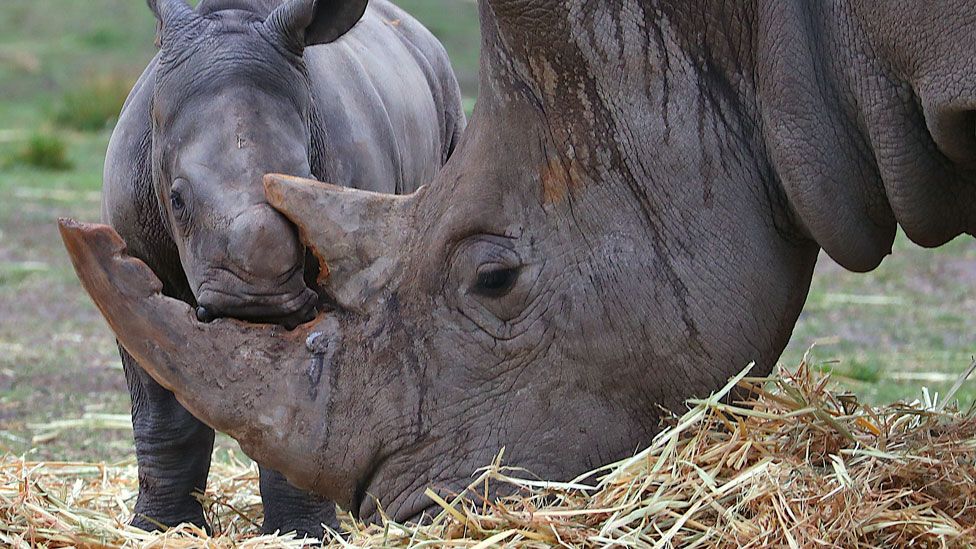
The use of infrasonic frequencies is likely an adaptation for rhinoceroses to keep in touch with each other where they inhabit dense vegetation and probably for females to advertise to males when females are receptive to breeding. Like elephants, rhinoceroses communicate using infrasonic frequencies that are below the threshold of human hearing. Despite their bulk, rhinoceroses are remarkably agile the black rhinoceros can attain a speed of about 45 km (30 miles) per hour, even in thick brush, and can turn around rapidly after missing a charge. The black rhinoceros ( Diceros bicornis) is normally ill-tempered and unpredictable and may charge any unfamiliar sound or smell. Most prefer to avoid humans, but males, and females with calves, may charge with little provocation. Rhinoceroses have poor eyesight but acute senses of hearing and smell. As of December 2014, only five northern white rhinoceroses remained in the world.

Northern white rhinoceros ( Ceratotherium simum cottoni) grazing at the Ol Pejeta Conservancy, Laikipia, Kenya. The feet of the modern species have three short toes, tipped with broad, blunt nails. Aside from the Sumatran rhinoceros, they are nearly or completely hairless, except for the tail tip and ear fringes, but some fossil species were covered with dense fur. All rhinos are gray or brown in colour, including the white rhinoceros, which tends to be paler than the others. Rhinoceroses are noted for their thick skin, which forms platelike folds, especially at the shoulders and thighs.

Modern rhinoceroses are large animals, ranging from 2.5 metres (8 feet) long and 1.5 metres (5 feet) high at the shoulder in the Sumatran rhinoceros to about 4 metres (13 feet) long and nearly 2 metres (7 feet) high in the white rhinoceros. Rhinoceroses are characterized by the possession of one or two horns on the upper surface of the snout these horns are not true horns but are composed of keratin, a fibrous protein found in hair. Rhinoceroses today are restricted to eastern and southern Africa and to subtropical and tropical Asia. Today the total population of all the rhinoceros species combined is probably fewer than 30,000. The precarious state of the surviving species (all but one are endangered) is in direct contrast to the early history of this group as one of the most successful lineages of hoofed mammals. sondaicus), and the Sumatran rhinoceros ( Dicerorhinus sumatrensis) live in Asia. The white rhinoceros and the black rhinoceros ( Diceros bicornis) live in Africa, while the Indian rhinoceros, the Javan rhinoceros ( R. Only African and Asian elephants are taller at the shoulder than the two largest rhinoceros species-the white, or square-lipped, rhinoceros ( Ceratotherium simum), which some divide into two species ( northern white rhinoceros and southern white rhinoceros ), and the Indian, or greater one-horned, rhinoceros ( Rhinoceros unicornis). Rhinoceros, (family Rhinocerotidae), plural rhinoceroses, rhinoceros, or rhinoceri, any of five or six species of giant horn-bearing herbivores that include some of the largest living land mammals.

This Time in History In these videos, find out what happened this month (or any month!) in history.

#WTFact Videos In #WTFact Britannica shares some of the most bizarre facts we can find.Demystified Videos In Demystified, Britannica has all the answers to your burning questions.Britannica Classics Check out these retro videos from Encyclopedia Britannica’s archives.


 0 kommentar(er)
0 kommentar(er)
